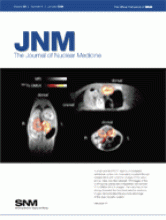Optical molecular imaging: Luker and Luker provide an overview of current optical imaging technologies for preclinical and clinical applications and highlight the potential of these techniques in advancing molecular medicine.
Page 1

V/Q scans remain valuable: Freeman compares the advantages of traditional ventilation-perfusion scintigraphy and the rapidly increasing use of multidetector CT angiography in the detection of pulmonary embolic disease, with special reference to radiation exposure.
Page 5
Weighing posttherapy PET benefits: Juweid reviews supporting evidence and recent international recommendations for routine use of 18F-FDG PET for posttreatment assessment of patients with Hodgkin's disease and diffuse large B-cell lymphoma.
Page 9
PET and lymphoma response: Terasawa and colleagues report on a systematic metaanalysis of the utility of 18F-FDG in detecting residual disease after first-line therapy for Hodgkin's disease and aggressive non-Hodgkin's lymphoma.
Page 13
Complementary PET tracers: Beer and colleagues describe investigations to determine the extent and nature of correlation between 18F-galacto-RGD and 18F-FDG PET assessments of αvβ3 expression and glucose metabolism, respectively, in cancer patients.
Page 22

α-Particle radioimmunotherapy: Zalutsky and colleagues explore the feasibility of regionally targeted, postresection radiotherapy with a 211At-labeled monoclonal antibody in patients with recurrent malignant brain tumors.
Page 30

Probabilistic MCA atlas: Kim and colleagues describe a population-based technique for the use of SPECT in generating probabilistic maps of blood flow distribution in the middle cerebral artery.
Page 39
Mapping cortical glucose consumption: Klein and colleagues investigate the applicability of cortical flattening of MR images coregistered to high-resolution research tomographic 18F-FDG PET.
Page 44

Resolving 3D 15O brain PET: Ibaraki and colleagues compare 3D quantitative 15O PET with 2D PET in assessment of brain pathophysiology and discuss optimal means for scatter correction.
Page 50
PET and cochlear implants: Coez and colleagues analyze cochlear implant activation of human temporal voice areas using a standardized H215O PET paradigm adapted from previous functional MR imaging studies.
Page 60

18F-fluoride bone scans: Grant and colleagues provide an educational overview of 18F-fluoride PET in skeletal imaging, including production, pharmacology, dosimetry, clinical applications in both benign and malignant disease, and practical and technical issues.
Page 68

High-resolution PET insert: Wu and colleagues detail the development of a prototype system to evaluate an insert device designed to achieve higher resolution with an existing general-purpose animal PET scanner.
Page 79
Small-animal SPECT/MRI: Goetz and colleagues report on the development of a pinhole SPECT/low-field MRI hybrid system with potential as a low-cost solution for anatomic and functional preclinical molecular imaging.
Page 88
In vivo islet cell SPECT: Tai and colleagues visualize both reporter gene expression in and location of transplanted pancreatic cells in living mice using dual-isotope SPECT, a technique with promise in monitoring innovative treatments for diabetes.
Page 94
64Cu-Nanoparticle lung imaging: Rossin and colleagues evaluate the use of PET to image lung uptake and distribution of radiolabeled and antibody-coated fluorescent nanoparticles and discuss the potential for this approach in preclinical screening of novel drug delivery agents.
Page 103

Receptor imaging in prostate cancer: Zhang and colleagues describe the development of a probe specific for a 64Cu-labeled VPAC1 receptor and initial PET imaging of experimental and spontaneous human prostate cancers in mice.
Page 112

99mTc-GSA imaging in liver regeneration: de Graaf and colleagues report on 99mTc-DTPA-galactosyl serum albumin scintigraphy combined with SPECT for the assessment of liver function and liver functional volume in normal and regenerating rat livers.
Page 122
microPET imaging of c-Met antibody: Tseng and colleagues use small animal 18F-FDG PET to investigate the efficacy of a novel antineoplastic chemotherapeutic agent and discuss the potential of this approach in assessing early response to therapy.
Page 129
11C-Methionine PET in tumor differentiation: Zhao and colleagues detail the respective potentials of 18F-FLT and 11C-methionine PET in differentiating malignant tumors from granulomas and compare these capabilities with those of 18F-FDG PET.
Page 135
Destabilized HSV1-TK reporter systems: Hsieh and colleagues describe the creation of a transcription reporter and molecular probe that allow for dynamic studies of short-time-scale gene expression events.
Page 142

Electron dose distribution: Champion and colleagues introduce a Monte Carlo code for assessing electron dose for isolated 131I in spheres of various sizes, provide representative S values, and discuss the potential for evaluating electron map deposits for any isotope.Page 151

Pretargeting with bispecific antibodies: Goldenberg and colleagues report on the “Dock-and-Lock” method, a new approach to developing bioactive targeting molecules with multivalency and multifunctionality for improved cancer imaging and therapy.
Page 158

ON THE COVER
In small-animal SPECT, regions of increased radiotracer uptake are more easily localized through coregistration with anatomic images of the same animal. Here, low-field-strength MR images of the 3 orthogonal planes are coregistered with pinhole 99mTc-DMSA SPECT images. The matching of the kidneys between the functional and the anatomic images demonstrates the practical advantage of this dual-modality system.

See page 91.







